

Future Timeline. Exocortex. An exocortex is a theoretical artificial external information processing system that would augment a brain's biological high-level cognitive processes.
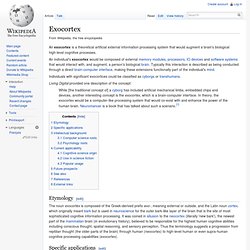
An individual's exocortex would be composed of external memory modules, processors, IO devices and software systems that would interact with, and augment, a person's biological brain. Typically this interaction is described as being conducted through a direct brain-computer interface, making these extensions functionally part of the individual's mind. Individuals with significant exocortices could be classified as cyborgs or transhumans. Living Digital provided one description of the concept: While [the traditional concept of] a cyborg has included artificial mechanical limbs, embedded chips and devices, another interesting concept is the exocortex, which is a brain-computer interface.
Etymology[edit] Specific applications[edit] In 1981 Steve Mann designed and built the first general purpose wearable computer. Intellectual background[edit] IBM produces first working chips modeled on the human brain. IBM has been shipping computers for more than 65 years, and it is finally on the verge of creating a true electronic brain.
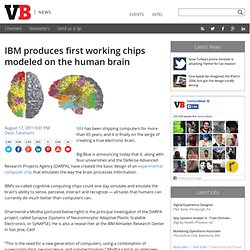
Big Blue is announcing today that it, along with four universities and the Defense Advanced Research Projects Agency (DARPA), have created the basic design of an experimental computer chip that emulates the way the brain processes information. IBM’s so-called cognitive computing chips could one day simulate and emulate the brain’s ability to sense, perceive, interact and recognize — all tasks that humans can currently do much better than computers can. Dharmendra Modha (pictured below right) is the principal investigator of the DARPA project, called Synapse (Systems of Neuromorphic Adaptive Plastic Scalable Electronics, or SyNAPSE). He is also a researcher at the IBM Almaden Research Center in San Jose, Calif.
We wrote about the project when IBM announced the project in November, 2008 and again when it hit its first milestone in November, 2009. Cognitive radio. Description[edit] In response to the operator's commands, the cognitive engine is capable of configuring radio-system parameters.
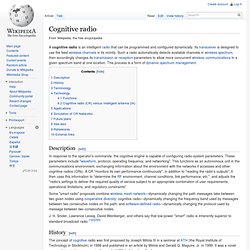
These parameters include "waveform, protocol, operating frequency, and networking". This functions as an autonomous unit in the communications environment, exchanging information about the environment with the networks it accesses and other cognitive radios (CRs). A CR "monitors its own performance continuously", in addition to "reading the radio's outputs"; it then uses this information to "determine the RF environment, channel conditions, link performance, etc. Some "smart radio" proposals combine wireless mesh network—dynamically changing the path messages take between two given nodes using cooperative diversity; cognitive radio—dynamically changing the frequency band used by messages between two consecutive nodes on the path; and software-defined radio—dynamically changing the protocol used by message between two consecutive nodes.
J. History[edit] Aubrey de Grey. Aubrey David Nicholas Jasper de Grey (/dəˈɡreɪ/; born 20 April 1963[5])[6] is an English author and theoretician in the field of gerontology and the Chief Science Officer of the SENS Research Foundation.

He is editor-in-chief of the academic journal Rejuvenation Research, author of The Mitochondrial Free Radical Theory of Aging (1999) and co-author of Ending Aging (2007). He is known for his view that medical technology may enable human beings alive today to live to lifespans far in excess of any existing authenticated cases. Early life and education[edit] De Grey was born and brought up in London, England.[12] He told The Observer that he never knew his father, and that his mother, an artist, encouraged him in the areas she herself was the weakest: science and mathematics.[3] He was educated at Sussex House School[13] and Harrow School.
Aubrey de Grey says we can avoid aging. Generational list of programming languages. Here, a genealogy of programming languages is shown.
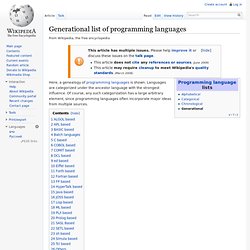
Languages are categorized under the ancestor language with the strongest influence. Of course, any such categorization has a large arbitrary element, since programming languages often incorporate major ideas from multiple sources. ALGOL based[edit] APL based[edit] D-Wave Systems. D-Wave Systems, Inc. is a quantum computing company, based in Burnaby, British Columbia.
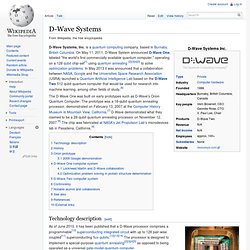
Simulated reality. Simulated reality is the hypothesis that reality could be simulated—for example by computer simulation—to a degree indistinguishable from "true" reality.
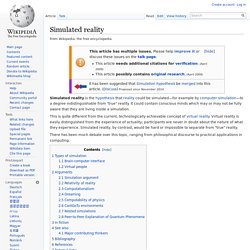
It could contain conscious minds which may or may not be fully aware that they are living inside a simulation. This is quite different from the current, technologically achievable concept of virtual reality. Virtual reality is easily distinguished from the experience of actuality; participants are never in doubt about the nature of what they experience. Simulated reality, by contrast, would be hard or impossible to separate from "true" reality. There has been much debate over this topic, ranging from philosophical discourse to practical applications in computing. Types of simulation[edit] Brain-computer interface[edit] Virtual people[edit] UCSB scientists discover how the brain encodes memories at a cellular level. (Santa Barbara, Calif.) –– Scientists at UC Santa Barbara have made a major discovery in how the brain encodes memories. The finding, published in the December 24 issue of the journal Neuron, could eventually lead to the development of new drugs to aid memory.
Autonomic Computing. The system makes decisions on its own, using high-level policies; it will constantly check and optimize its status and automatically adapt itself to changing conditions.

An autonomic computing framework is composed of autonomic components (AC) interacting with each other. An AC can be modeled in terms of two main control loops (local and global) with sensors (for self-monitoring), effectors (for self-adjustment), knowledge and planner/adapter for exploiting policies based on self- and environment awareness.